
New World Quarantine Page Menu: 1 2 3 4 5 6 7 8 9 Next>>
New World Quarantine During the Golden Age of Piracy, Page 3
Purpose of Maritime Quarantine - Yellow Fever Description
"It is true that le mal de Siam [Yellow fever] carries off many people, but this pest is equally common among the Dutch, Portuguese, French and other Europeans in the Islands." (Pere Jean-Baptiste Labat, The Memoirs of Pére Labat 1693-1705, 1970, p. 121)
Like smallpox, the virus eventually called yellow fever led to scattered attempts to quarantine ships in the North American colonies during the golden age of piracy. These quarantine rules were sporadically enacted and enforcement was difficult at best. No lazarettos built to quarantine people who could potentially bring yellow fever into a city; instead, all shipboard arrivals were required to remain aboard their vessels to serve out quarantine, in some rare cases being transferred to isolated hospitals if they were available.
Theory

Artist: John Vanderbank - Sir Hans Sloane (Early 18th c.)
In 1661, when Swiss physician Felix Christan Spoeri was visiting Barbados he mentioned the 'Contrey Diseas' in which "the people turn quite yellow, their stomachs and legs swell" which struck newcomers to the island. He lists three things he felt were responsible for this, the first two being a change of diet and the hot climate and the third being the "use [of] hammocks instead of beds... out of ignorance people suspend them from two trees under they open sky and thus they catch the dew. This is highly detrimental to everyone since the stomach, which is the kitchen of the body, loses its warmth; because of the cold, the body's pores clog resulting in bad blood which usually emaciates people and causes ultimate death."1
When doctor Hans Sloane visited Jamaica in 1687, he described a fever, one of the symptoms of which was the patient turning yellow. He explained that the locals referred to this as 'the Seasoning' because they said "every New-comer before they be accustomed to the Climate and Constitution of the Air in Jamaica, are to have an acute Disease, which is thought to be very dangerous, and that after this is over, their Bodies are made more fit to live there, with less hazard than before"2. While this agrees with Dr. Spoeri's analysis of the situation, Sloane points out that it was not entirely accurate because some long-term inhabitants contracted this fever while some of the new arrivals did not.
Physician Richard Towne suggests that the central problem in yellow fever (which he calls febris ardens biliousa) is that the blood is "overcharged and too much inflamed with" bile, probably referring to yellow bile, one of the four bodily humors. He goes on to suggest that nature requires the bile to deal with the fever, although by bleeding a patient, excess bile could be removed, which "is a great Assistance to Nature to relieve her in this Point, and (as it were) take Part of her Work off her Hands; ...there will still remain a sufficient Quantity [of yellow bile] for her to combat with."3
Dr. Henry Warren agrees with Spoeri and Towne that problems with the patient's blood were at the root of the disease, although he doesn't necessarily agree with everything they say. He provides a most extensive theory to explain the problem. Warren says,
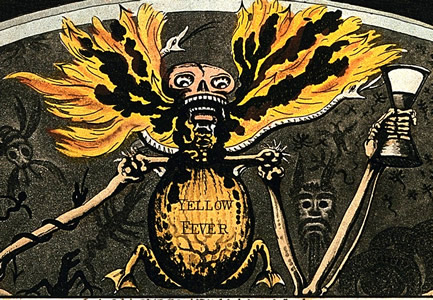
Artist: att Abraham James
The torrid zone. Or, blessings of Jamaica - Yellow Fever Allegory (1800)
this Fever is truly of the Pestilential Kind, and ought properly to be called by no other Denomination. It resembles, very nearly (except that the Condition of the Blood is not the same) the Pestilential Fever [probably typhus] described by Dr. Sydenham, which continued for some time after the Plague of London; and it is attended with many Appearances, peculiar to the Plague itself) the Plague-boil and the Rapidity and Ferocity of the Symptoms only excepted4
Unlike Towne, Warren suggests that the disease does not proceed from the humor bile, but instead "from a Colliquation [breakdown of tissue], and perhaps a gangrenous Diathesis of the sanguineous Mass [breakdown of the blood], occasioned by the Force of the Deleterious Venom that had been infused into it."5 He feels that because "Strangers and New-comers [to Barbados], whose Blood is purest and least impregnated with exalted Oils and Salts" are the most likely people to contract yellow fever while the natives, "whose Juices we may reasonably suppose to be more acrid [sharp] and alcalescent [alkaline]" are not, so corrupted bile cannot be the cause of the illness.6 He further points out that most fevers cause the patient's skin to yellow, something not typically thought to be due to the presence of bile.
Warren lists three ways he believes the virus can be transmitted.
1st, By immediate Contact of the distempered Subject, either living or dead, his Clothes, Spittle, or the like; 2dly, By inspiring the Contagious Effluvia into the Lungs along with the Air, or by swallowing them down into the Stomach along with the Spittle or Food; these two Ways are presumed to be the most ordinary; and 3dly, By being from the ambient Air insinuated or imbibed into the Absorbent Pores of the Skin, and so mixing soon with the Lympha, and then with the Venous Blood, along with which it is directly carried to the Heart7
His concept of the way the virus was transmitted mirrors the way the plague virus was thought to work. In his third method of transmission, he even suggested that yellow fever infected the lymph system in the same manner in which the plague was thought to do.
Of course, none of the contemporary authors identified the real cause of yellow fever.
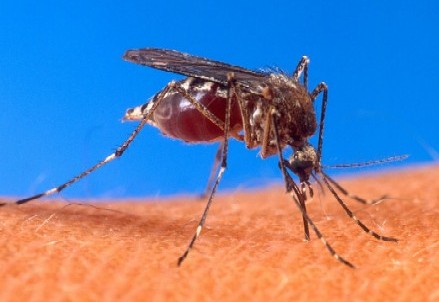
Photo: US Dept. of Agriculture - Aedes aegypti biting human
This was not to be explained until Carlos Juan Finlay wrote and read a paper called "The Mosquito Hypothetically Considered as the Agent in the Transmission of Yellow Fever" in 1881 at a session of in the Academy of Medico-Physical and Natural Sciences of Havana. In it, Dr. Finlay "points to the Culex mosquito, known today as the Aedes aegypti."8
The World Health Organization today explains that there are actually a variety of mosquitoes of the Aedes and Haemogogus species which can transmit the virus. It is carried "from one host to another, primarily between monkeys, from monkeys to humans, and from person to person."9 John Robert McNeil explains that "the mosquito is of African origin, and presumably first came to the Americas aboard slaving ships. No native American mosquito occupied A. aegypti's favored niche, so it had no direct competition."10 This mosquito breeds in water vessels, ideally laying their eggs on the damp walls of such vessels. So the damp environment of a wooden ship would have been the perfect environment for them to prosper.
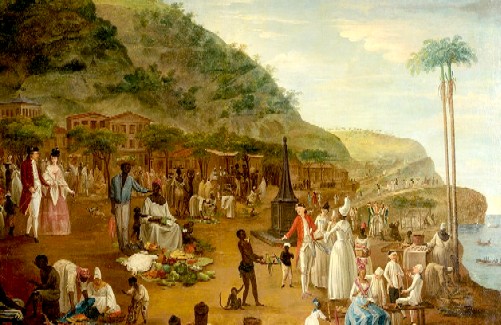
Artist: Le Masurier - Marché [Market], St Pierre, Martinique (18th century)
Dr. Warren suggests that the two outbreaks of yellow fever which he witnessed - one in 1726 and the other in 1733 - were likely caused by the arrival of ships. In the first case, he said it was thought that the virus came from the arrival of the British fifth rate Man-of-War Lynn from Martinique.11 In the second, the virus "was likewise from Martinique, from whence it was brought to us by an English Surgeon, who died of it here in a few Days after his Arrival."12 The surgeon, a Mr. Nelson, told Warren that the virus was originally brought to the port at St. Pierre, Martinique by a French vessel contained in bales from Acre, Israel, "where the French drive a considerable Trade, tho' the Place is seldom free from Pestilential Infections."13
1 Felix Christian Spoeri, "A Swiss Medical Doctors Description of Barbados in 1661," Alexander Gunkel and Jerome Handler, eds., The Journal of the Barbados Museum and Historical Society, May, 1969, p. 6; 2 Hans Sloane, A Voyage to the Islands Madera, Barbados, Nieves, St Christophers and Jamaica, Vol. 1, 1707, p. xcviii; 3 Richard Towne, A Treatise of Disease Most Frequent in the West-Indies, 1726, p. 28-9; 4 Henry Warren, A Treatise Concerning the Malignant Fever in Barbados, 1741, p. 3; 5 Warren, p. 12; 6 Warren, p. 13; 7 Warren, p. 24; 8 Dr. Pedro Nogueira, “The Early History of Yellow Fever”, Yellow Fever, a symposium in commemoration of Carlos Juan Finlay, 1955, p. 4; 9 WHO Fact Sheet: Yellow Fever, 2014, p. 3; 10 John Robert McNeill, Mosquito Empires, 2010, p. 41; 11 British Fifth Rate frigate 'Lynn' (1715), threedecks.org, gathered 2/10/19 & Warren, p. 4; 12 Warren, p. 4; 13 Warren, p. 5;
Conditions Conducive to Yellow Fever
Like the plague, a variety of conditions were identified by contemporary authors as favorable to yellow fever. Richard Lignon noted in the mid-17th century that Bridgetown,
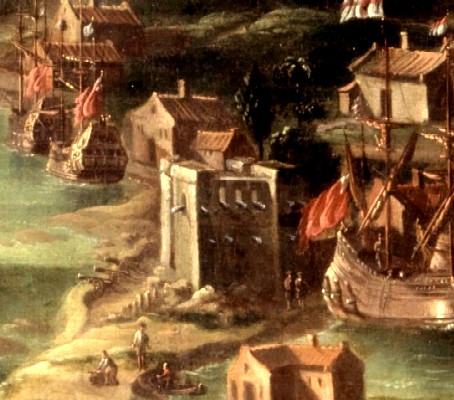
Artist: Isaac Sailmaker -
Ships, Fort and Houses on Barbados (c. 1694)
Barbados was an unhealthy location. "For, the ground being somewhat lower within the Land, than the Sea-banks are, they spring Tides flow over, and there remains, making a great part of that flat, a kind of Bog or Morass, which vents out so loathsome a favour, as cannot but breed ill blood and is (no doubt) the occasion of much sickness to those that live there."1 He notes that when he arrived on the island in 1647 a "sickness raign’d so extreamly, as the living could hardly bury the dead; ...they threw the dead carcases into the bog, which infected so the water, as divers that drunk of it were absolutely poysoned, and dyed in few hours after; but others, taking warning by their harms, forbear to taste any more of it."2
Physician Henry Warren disagrees, explaining that the land on Barbados, "in respect of the other Islands, is the best cultivated, and entirely free from Lakes or Marshes". He admits that the land is low in some places, but that it "is agreeably diversified with Risings and Hills".3
In disagreement with Warren's assessment, Griffith Hughes said that the virus "is most commonly rife and fatal in May, June, July, and August"4. He continues, "Neither the Alteration of the Weather or Winds, nor the different Seasons of the Year, have ever, of them selves, been able to produce this contagious Disease among us"5. Warren explained that if that were true, "sultry Heats and long intolerable Droughts of some [years], the almost incessant Rains of others, or the tempestuous Weather of many, and that from uncommon Points of the Compass too, [it] must surely, in some degree or other, have given Rise to such an Epidemical Malignity, if it could possibly be derived from such Causes"6. Contemporary physician John Williams sided with Warren; "Nor does this Fever appear to have any particular Constitution; for we have it at all Seasons of the Year."7
Warren identified three individual conditions he felt encouraged the spread of yellow fever.
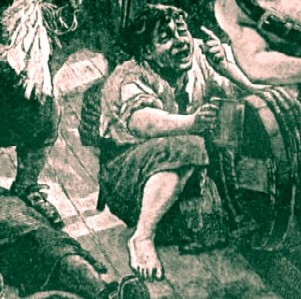
Artist: Amedee Forestier
Sailor on a Ship, From They Stopped Only To Drink,
From The world went very well then, By Walter Besant (1888)
1st, After hard Drinking and sitting up late o' Nights, and then exposing the Body to the damp, chilly, Night Air; 2dly, Upon any too violent Exercises of the Body, by Labour, Walking, Running, Dancing, and the like, and then cooling in the Air, too suddenly, without sufficiently defending the open Pores; 3dly, Upon drinking large Draughts of cool Liquors, particularly cold Water, upon the aforesaid Occasions.8
Warren frequently mentions how common the fever was among sailors, tying their behavior to such causes. He explained that they "have perhaps less Conduct in their Way of living than any Sett of People in the World, drinking ever hard of the vilest and cheapest strong Liquors when ashoar, and then going off upon the Water with Breasts open, and their Bodies poorly covered, even in the Night"9. He also notes that "if there be any Impurity in the Air of our Island at all, it must be only about the Wharfs, where always is the chief Resort of Sailors, either for Business or Pleasure; and it is not unlikely, that those may be the most proper Places for harbouring, improving, and spreading the Contagion, when once it has got Footing amongst us."10
However, Warren does not consider air to be the primary cause of the illness. He elsewhere defends Barbadian air, explaining that it "is in general remarkably fresh and pure, and probably more salubrious [healthy] than that of any other Sugar Colony."11 He explains that Barbados is "to the Windward [receiving fresh wind in front] of all others, and at a greater distance from any Part of the Northern or Southern Continents of America" so that ill winds should not reach it from other places and are therefore not the root cause of the illness.12 Warren did believe that the virus could be transmitted from one infected person to another
Sugar Refining Pots and Jars, Affinerie des sucres, From Encyclopedie, ou,
Dictionnaire Raisonne des Sciences, Vol 1, Denis Diderot, Plate VI, (1762)
via the air as suggested in the previous section. He did not think the air was intrinsically unhealthy in either of these cases. Rather, the distemper occured in the first case because the patient openly received cold and wet air after doing hard work and, in the second, because the air has been infected by a patient already laboring under the fever.
John Williams agreed in many ways with Warren, explaining that yellow fever "is generally brought on by suddenly cooling the Body and checking perspiration after hard Exercise in the Heat of the Sun; for when the Sailors go to cut Wood for the Ships use, they are obliged to row several Leagues against a Current and then jump into the Water in order to carry the Wood on Shoar."13
None of this was correct. Conditions amenable to yellow fever could not be determined until the source of the illness was known, something that didn't happen for another 150 years. Once the mosquito and its method of reproduction were identified, historians could look back and determine how yellow fever spread throughout the Caribbean. The Aedes aegypti mosquito was tremendously aided by the sugar industry. Deforestation to procure wood to boil the sugarcane as well as provide sugar-planting locations reduced the mosquitos' natural enemy - birds. Water stored during the dry season in kegs, barrels and buckets as well as clay pots used to decrystalize sugar all provided perfect containers for these mosquitos to lay their eggs. "It also became better for feeding. Sugar meant population growth, urbanization, and hence more frequent blood meals for mosquitoes, especially those like A. aegypti that hanker for human blood."14 Ironically, Warren's proclamation that there couldn't be a healthier place than the sugar colonies of Barbados was totally incorrect.
1,2 Richard Lignon, Of the Island of Barbadoes, 1673, p. 25; 3 Henry Warren, A Treatise Concerning the Malignant Fever in Barbados, 1741, p. 7; 4 Griffith Hughes, A Natural History of Barbados, 1750, p. 37; 5,6 Warren, p. 8; 7 John Williams, An Essay on the Bilious, or Yellow Fever of Jamaica, 1750, p. 11; 8 Warren, p. 24; 9 Warren, p. 19; 10 Warren, p. 20; 11 Warren, p. 7; 12 Warren, p. 7-8; 13 Williams, p. 11; 14 John Robert McNeill, Mosquito Empires, 2010, p. 49
Yellow Fever Patient Symptoms
A variety of different authors mention the symptoms found in those afflicted with yellow fever. As with the bubonic plague, Griffeth Hughes warned that in Barbados, "The same Symptoms did not always appear in all Patients, nor alike in every Year when it visited us."1 Still, there was quite a bit of overlap in the period descriptions of the progress of this virus.
Not surprisingly, physician Henry Warren provides the best period framework for understanding how the disease revealed itself.
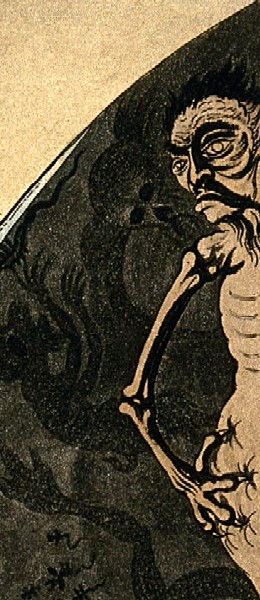
Artist: att Abraham James
Figure Representing the 'Dry Gripes' or Stomach
Pain,
From The torrid zone. Or, blessings of
Jamaica -
Yellow Fever Allegory (1800)
He broke the disease into three stages, although only the first two were related to the initial symptoms. He called the first stage the 'Colliquative State', referring to the liquefaction of bodily tissue that he felt was behind the disease. The second stage was the 'Yellow State', referring to the color of the patient's skin, although he explained that this also described the "compleat Colliquation or Dissolution of the red Globules of the Blood into a yellowish Serum, which will naturally soon give that Tincture to the whole Skin", once again relating it to his understanding of the process.2
Warren said that the first stage - the colliquative state - could last from one to three or more days with the duration depending on "the Degree of Infection, Constitution of the Patient, or the different Manner of Treatment"3. His list of symptoms included
a sudden Faintness, and frequently a Giddiness too, then a Chilliness and Horror, which are immediately succeeded by an Ardent Fever, with severe darting Pains in the Head and Small of the Back; the Face intensely flush'd, Redness and Burning in the Eyes, high-coloured crude Urine, the Pulse in some quick, high, and throbbing; in others, quick, low, and vacillating; the Skin sometimes (tho' rarely) parched and dry, but oftner, and indeed generally, moist and disposed for Sweat; early Deliria, great Tightness, Anxiety, and Oppression about the Præcordia [area of the chest near the heart]; Difficulty of Respiration, Sickness of the Stomach, with Reachings to vomit: The Blood now drawn is florid [bright red] and rarified, with evident Marks of Colliquation [tissue breakdown], and without the least Sign of Size, that I could ever once observe; the Insula or Crassamentum [‘solid’ part of the blood] (even when cool) upon moving it, undulates like Water in a Bason, and has sometimes blackish Spots here and there upon its Surface, with much yellowish Serum, upon which it extends itself wide and thin: Soon after, all these Symptoms are aggravated with almost perpetual Reaching and Vomiting, great Inquietude, incessant Jactations [shaking while sleeping], no Ease in any Posture, scarce any Rest or Sleep, or that at best disturbed and unrefreshing.4
This long list of symptoms was futher divided up by Warren according to the various types of patients,
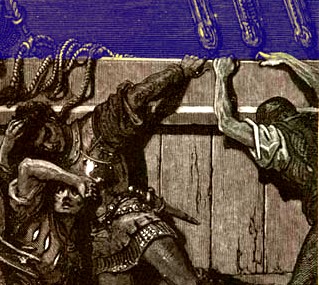
Artist: Gustav Doré
Men in Agony, From Rime of the Ancient Mariner (1862)
the divisions of which were probably based on the individual cases he treated.
Physician Hans Sloane's list of symptoms in the first stage agree with many of those given by Warren. They include "a great pain in the Head, and Back about the Loins, a Reaching Vomit to no purpose, a very great pain in the Limbs, and all over the Body, as in a Rheumatism, which seem’d to be form the violent heat and boiling of the Blood in the Vessels and Membranes."5 He suggests that these symptoms lasted twelve to eighteen hours, a time period in line with Warren's. This is followed by 'a great weakness', which he found unusual, even suggesting that "this last very great weakness and faintness might not come from some other Distemper"6.
In 1726, Physician Richard Towne, described yellow fever as starting with chilliness and shivering followed by a high fever, which was most intense around the heart. "This Heat is attended with a high, strong and rapid Pulse, Heaviness in the Eyes, a throbbing Pain in the Head, and violent Beating of the temperal Arteries, a thick and laborious Respiration, Nauseousness and Reaching to vomit... great Anxiety, pain in the Back and Loins, and an uneasy Lassitude in all the Limbs"7.
Warren said that his second stage - the yellow state - began with a "universal Yellowness all over the Surface of the Body, generally first discoverable in the Coats of the Eyes, with dark or blackish Circles round their Orbits [eyes]"8 This stage
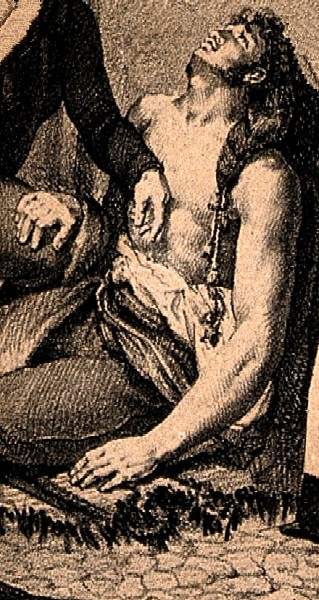
Artist: after J. Aurego
Man With Yellow Fever Suffering From Extreme Weakness (1821)
could last from a few hours to two days and, on rare occasion, 'a good deal longer.' He goes on to describe the other symptoms he associated with this stage:
the Fever abates, the Pulse flags, the Skin all over moist and clammy, often with a very sensible Chilliness, and the Urine of a dark, deep, croceous [yellow] Hue: The Tongue at this Time appears generally moister and cleaner than in the former Stage, the Tip and Edges of it, as well as the Lips and Gums, of a, more florid Red than usual, as if Blood was ready to start through them. Now frequently the Patient has a Heaviness to doze, and grows comatose, shewing Signs of much Confusion and want of Memory, whenever awakened from his unavailing Slumbers. However, it often happens about this Time, that (without a Coma) he shall receive some comfortable Rest and Sleep, which is often mistaken for a joyful Prospect of Recovery; but this flattering Scene is of very short Continuance.9
Sloane's description notes that the yellowed skin was accompanied "by great slothfulness. Afterwards the yellow Face and Eyes, as well as thick yellow Urin discover’d it plain. …I remembered the Serum was so discolour’d in some, that all the Pustles rose on the Skin, were fill’d with an Ichor as yellow as the infusion of Curcuma [tumeric] or Saffron in water."10
Towne mentioned a follow up stage which occurs about twelve hours after the onset of the illness. The symptoms he identified at this stage include "a dry, harsh, rough, and discoloured Tongue, insatiable Thirst, Soreness all over the Body, great Restlessness and Deliria."11
Father Jean Baptiste Labat gives a very descriptive first person account of yellow fever which he contracted in Fort St. Pierre, Martinique in 1697. It includes both of Warren's stages, although it tends to focus more on the second stage symptoms.
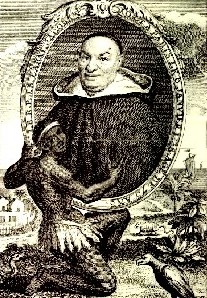
Jean-Baptiste Labat, From Nouveau Voyage
aux Isles de l'Amerique, Vol 1 (1722)
I felt an attack of a violent pain of my heart, and of my loins, accompanied by a fever; symptomes of the ''mal de Siam'. I was bled first at the foot, and then at the arm. This last bleeding made me the despair of my life, because I fainted, and in spite of all that could be done, I remained unconcious for nearly an hour. I came back at last like one from a deep sleep; A few hours after, I had a spitting, or rather a very strong vomiting of blood, which sent me into a series of convulsions, when instead of pure blood and liquid, I was obliged to throw lumps of a thick, over-heated blood. It lasted nearly twenty-four hours. During this time my body was covered with purple spots from the head to the feet. The spots, which were of the size of the hand, and of different colors, rose substantially above the skin. I suffered great pains on the third and fourth day. The fifth I was surprised by a lethargy, or involuntary sleep, which could not be overcome. .... I slept nearly twenty hours without awakening, and during that time I had a crisis or sweat so abundant that it soaked several mattresses, one after the other. At last I awoke very surprised to find myself in another bed...12
Labat's description contains a variety elements nearly all of which are found in the descriptions provided by other authors during the period.
Modern sources agree with Warren's description for the most part. The World Health Organization explains that the virus has a three to six day incubation period after receiving the infected mosquito bite. They divide the virus into two stages.
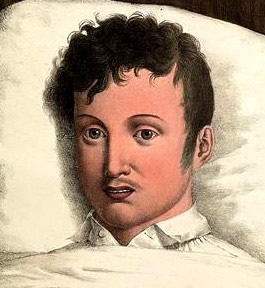
Patient in Acute Stage of Yellow Fever, From
Observations sur la fievre jaune, Wellcome (1819)
"The first, acute', phase usually causes fever, muscle pain with prominent backache, headache, shivers, loss of appetite, and nausea or vomiting. Most patients improve and their symptoms disappear after 3 to 4 days."13 Authors S.L Kotar and J. E. Gessler mention these symptoms, but add "arrhythmia (characterized as ‘irregular heartbeats’), bleeding that may progress to hemorrhage, coma, decreased urine output, delirium, ... red eyes, face and tongue, seizures... and occasionally [vomiting] blood."14
The second stage identified by the WHO is only experienced by fifteen percent of the patients who get the virus. They explain that it occurs within twenty-four hours of remission from the first stage. "High fever returns and several body systems are affected. The patient rapidly develops jaundice and complains of abdominal pain with vomiting. Bleeding can occur from the mouth, nose, eyes or stomach. Once this happens, blood appears in the vomit and faeces. Kidney function deteriorates."15 Kotar and Gessler add heart and liver deterioration as other possible symptoms.16 The WHO explains that half of the patients who reach this stage "die within 10 to 14 days, the rest recover without significant organ damage."17
1 Griffith Hughes, A Natural History of Barbados, 1750, p. 37; 2 Henry Warren, A Treatise Concerning the Malignant Fever in Barbados, 1741, p. 11-2; 3 Warren, p. 10; 4 Warren, p. 9-10; 5 Hans Sloane, A Voyage to the Islands Madera, Barbados, Nieves, St Christophers and Jamaica, Vol. 1, 1707, p. xcvi - xcvii; 6 Sloane, p. xcvii; 7 Richard Towne, A Treatise of Disease Most Frequent in the West-Indies, 1726, p. 20-1; 8 Warren, p. 10; 9 Warren, p. 10-1; 10 Sloane, p. xcvii; 11 Towne, p. 21; 12 Jean Baptiste Labat, Nouveau Voyage aux Isles de l'Amerique, Vol. 4, 1742, p. 307-9, Translated by the author; 13 WHO Fact Sheet: Yellow Fever, 2014, p. 1; 14 S.L Kotar and J. E. Gessler, Yellow Fever: A Worldwide History, 2017, p. 7; 15 WHO, p. 1; 16 Kotar and Gessler, p. 8; 17 WHO, p. 1
Yellow Fever Patient Signs of Impending Mortality
As with the period descriptions of the plague, the medical men of this time specifically noted symptoms that indicated that the patient would die of yellow fever. Physician Henry Warren refers to this as the third stage of the virus - the 'Gangrenous State'.
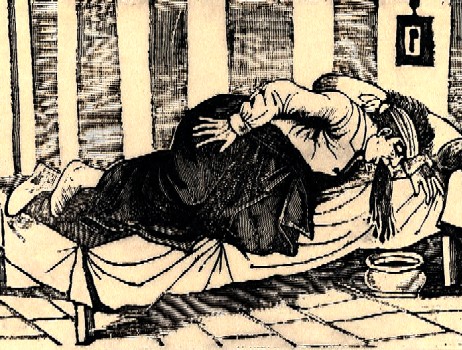
Artist: Jose Guadalupe Posada
Patient Vomiting Blood, From The Death of Aurelio Caballero From Yellow Fever (1892)
Warren gives an almost poetic introduction to the terminal signs of the fever, stating that "the Scene is again soon shifted, and now many terrible Harbingers of the expected Catastrophe appear."1 However, he quickly switches to a more brutal description of the actual symptoms.
Blood flowing out by the Nose and Mouth; large Quantities of black mortified Blood voided both by Vomit and Stool; the Urine almost quite black, the Pulse low, tottering, unequal, and intermittent; most difficult and laborious Breathing, Startings [involuntary body movements], horrible Anxieties, with almost constant Deliria, Faintings, Hiccups, cold Sweats, Death-like Coldness in all the Extremities, though at the same time an intense burning Heat, with torturing Labour and Oppression about the Heart; now an intire Loss of Reason and all the outward Senses too, with livid Spots in many Parts of the Body, principally about the vital Region, which Symptoms are soon succeeded by Death dreadful to the Beholders.2
There is quite a bit of overlap with Warren's description of the second stage of yellow fever.
Physician Richard Towne explains that during what he calls the 'last stage', "the Patient labours under a deep Coma; Oppression of the Præcordia [region of the heart]; heaving of the Lungs; an interrupted Respiration; Tremblings of the Tendons; Convulsions, and cold clammy Sweats."3 He notes that the eyes will take on a 'saffron' [yellow] tincture around "twelve Hours after the Attack... and the sooner it appears, the more encouraging is the Prognostick"4. Towne explains that there is "a Suffusion of the Bile all over the Surface of the Body about the third Day."5 Around the fourth day, the patient starts "dispersing and throwing out of the Mass of Blood, that load of Bile, which is the principal Agent in this important Mischief."6
Griffeth Hughes' description of the final stages of yellow fever 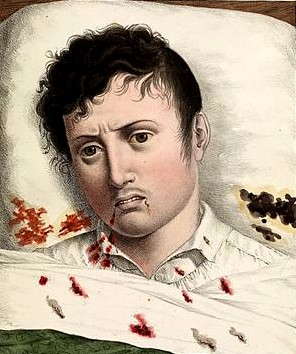
Patient in Late Stage of Yellow Fever, From
Observations sur la fievre jaune, Wellcome (1819)
from a 1715 epidemic on Barbados is a little less vivid, but it includes many of the same symptoms. He says that when a patient gets visibly worse, "he sometimes spits Blood, and that by Mouthfuls; as this continues, he grows cold, and his Pulse abates, till at last it is quite gone; and the Patient becomes almost as cold as a Stone, and continues in that State with a composed sedate Mind."7 He adds that the patient sometimes bleeds from the anus or nose, "but when the Blood issues from thence but in few Drops, it is a bad Prognostic, and is generally the Harbinger of Death."8 He says such patients are frequently hot and dry and have 'intolerable Pains' around their stomach. "It often also happens, that the sick Person shall lie almost stupid; and being asked how he does, say, He is very well; at other times he labours under the greatest Agonies, and Fits of Groanings."9
Both Warren and Hughes state that once a patient has perished, "the Body appears much fuller than before of livid Blotches, especially about the Region of the Præcordia [near the heart]"10. Hughes says that victims dying from yellow fever "appear livid in some Parts or other; or else marked with pestilential Spots, Carbuncles, or Buboes."11
It is fortunate that most people who contract yellow fever don't die from it. The World Health Organization notes that even today there isn't any treatment for the virus, "only supportive care to treat dehydration, respiratory failure and fever. Associated bacterial infections can be treated with antibiotics."12
1 Henry Warren, A Treatise Concerning the Malignant Fever in Barbados, 1741, p. 15; 2 Warren, p. 15-6; 3 Richard Towne, A Treatise of Disease Most Frequent in the West-Indies, 1726, p. 21-2; 4,5,6 Towne, p. 23; 7,8,9 Griffith Hughes, A Natural History of Barbados, 1750, p. 38; 10 Warren, p. 16; 11 Hughes, p. 38; 12 WHO Fact Sheet: Yellow Fever, 2014, p. 3

